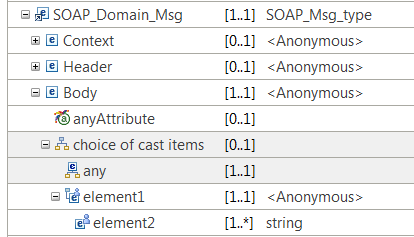Defining the structure of a complex user-defined element
You can define the structure of a complex type by using the Add Element function. You can reorder the position of elements in your complex structure. You can also use global types such as XML schemas, DFDL schemas, JSON schemas, and Swagger documents to set the type of user-defined elements.
Before you begin
In a message map, add a user-defined element with <Anonymous> type to your input or output assembly. For more information, see Adding and renaming a user-defined element.

About this task
- You can include simple type attributes, simple type elements, complex type elements, and repeatable elements in a user-defined complex type element.
- You can set the type of a user-defined element to a global complex type defined in an XML schema, DFDL schema, JSON schema, or Swagger document.
- When you set the type to a global type, you can configure the cardinality only through an XML schema or DFDL schema.
- When you add elements to a complex user-defined element, you define
the cardinality for each child element that you add. The cardinality
defaults to Minimum occurrence and Maximum
occurrence of 1. For more
information, see Configuring the cardinality of a user-defined element.
Note: You cannot change the cardinality in the Graphical Data Mapping editor for user-defined elements that are within the choice group that is created for you when you define elements at the level of the xsd:any wildcard. The cardinality is determined by the cardinality set on the xsd:any.
Procedure
Complete the following steps to define the structure of a complex element:
What to do next
Edit the message map, and define transformations between the input message assembly and the output message assembly. For more information, see Specifying a transform (mapping operation).